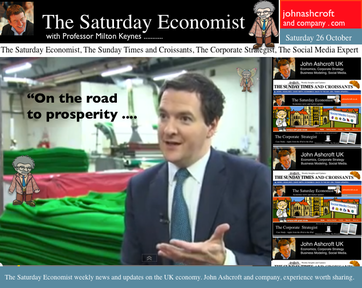 On the road to prosperity Chancellor Osborne greeted the GDP figures this week with the confident claim we are on the road to prosperity. “Britain’s hard work is paying off, we see that in the economic numbers today”. Indeed we do. Growth in the third quarter increased by 1.6% year on year, exactly as we had expected. Service sector growth continues to underpin the recovery, increasing by 1.9% with particularly strong growth in the distribution, hotels and leisure sector (3.8%). Construction output, boosted by developments in the housing market, increased by almost 5%. Manufacturing output was flat in Q3 up by just 0.1%. Of itself this is a measure of recovery. Output (goods) fell by almost 3% in the first quarter of the year. We expect the recovery in manufacturing to continue with strong growth of over 2% in the final quarter of the year. Our forecast for growth in the year as a whole is unchanged at 1.5%. We expect the economy to be running at trend rate (around 2.5%) in the final quarter. We are on the road to recovery, with prosperity for some, but not all, as growth will continue at 2.5% into 2014. Open for Business Open for business was the theme of a Mark Carney speech this week. The Governor of the Bank of England is shaking up the Bank of England significantly. Last week, Spencer Dale Chief Economist was on Twitter, in an online Agony Aunt economics session. This week, the Governor hired McKinsey and Deloitte to review the central bank's resources and identify cost savings. There will be blood, sweat and tears in Threadneedle Street, as the Old Lady sheds a few layers. The UK is at the heart of a renewed financial globalisation the headline of the Governors speech to celebrate the 125th anniversary of the Financial Times in London. The UK has a strong financial services sector which is to be sustained and developed. [Don’t kill the Golden Goose just because it bit the postman? is the message, if not the exact central bank wording on the subject.] To help the process, the Bank of England is open for business in supporting the banking sector. Facilities will be made available at lower coupon rates and covering a wider risk profile. “The Bank of England today is the friend of resilient banks, continuous markets, and good collateral”. Hurray! Now we have a sensible grasp on economics strategy from the Chancellor and a central banker who talks to the bankers. Whatever next? Borrowing Figures Well lower borrowing figures for one thing. This week, the ONS released the PSNBR figures for the month of September. In September 2013, public sector net borrowing excluding temporary effects of financial interventions (PSNB ex) was £11.1 billion. This was £1.0 billion lower than in September 2012, when it was £12.1 billion. There is more good news to come. Public Sector borrowing is set to fall to £104.5 billion in the current financial year compared to £115 billion in 2012/13. Given the acceleration of growth in the economy into the second half of the year, we believe borrowing could possibly fall below the £100 billion threshold for the year as a whole and below £90 billion in the following year. Good news for the Chancellor as tax receipts including VAT, capital gains and income tax increased by almost 5% in the first six months of the year. Spending on the other hand was up by just 2.4%. Public sector debt was £1.2 trillion at the end of September, equal to 76% of GDP. Of itself a prosperity challenge for the grandchildren. So what does this all mean? The economy is recovering and growing at a much faster rate into the final quarter. Base rates are now more likely to rise by around 50 basis points in 2015 rather than 2016. A short rate rise by the end of 2014 still has low odds given the prevarications in the USA. What happened to sterling? Sterling steadied against the dollar and moved down against the Euro. The pound closed at £1.6166 from £1.6174. Against the Euro, Sterling closed at €1.1713 from €1.1816. The dollar moved down against the yen closing at ¥97.4 from ¥97.7, closing at 1.3803 from 1.3682 against the Euro. Oil Price Brent Crude closed at $106.93 from $109.94. The average price in October last year was almost $112. We expect oil to average less than $110 in the month, with no real inflationary impact. Markets, pushed higher - The Dow closed at 15,570 up from 15,399. The FTSE closed at 6,721 from 6,623. The US debt deal is done. The rally is on. UK Ten year gilt yields closed at 2.63 from 2.72, US Treasury yields closed at 2.51 from 2.58. Gold closed at $1,352 from $1,313. The bulls have it, at least for last week. That’s all for this week, don’t miss The Sunday Times and Croissants out tomorrow and watch out for news of our Friday Financials Feature with Monthly Markets updates coming soon. Join the mailing list for The Saturday Economist or forward to a friend UK Economics news and analysis : no politics, no dogma, no polemics, just facts. John © 2013 The Saturday Economist, #TheSaturdayEconomist, by John Ashcroft and Company, Dimensions of Strategy and The Apple Case Study. The material is based upon information which we consider to be reliable but we do not represent that it is accurate or complete and it should not be relied upon as such. We accept no liability for errors, or omissions of opinion or fact. In particular, no reliance should be placed on the comments on trends in financial markets. The receipt of this email should not be construed as the giving of investment advice.
0 Comments
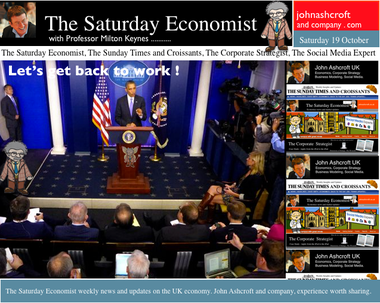 Economics news – news from Washington and Beijing ... Washington Good news from across the Pond, a Washington truce has been achieved. The US government has returned to work, Yosemite National Park is open, international creditors will be paid. The debt crisis is over. A twenty week truce has been secured. Markets rallied, the dollar slipped, Google shares breached the $1,000 level and the S&P 500 hit a new high. What more could we ask? Beijing In China, growth continued at 7.8% into the third quarter up from 7.5% in the second. For those fearing a hard landing, crash landing, soft landing, end of the world scenario, it is time to stop shorting the markets and buy in, the world is not coming to an end any time soon. London - Mortgages In the UK, mortgage lending increased by 32% in the third quarter compared to Q3 last year. FLS and Help to Buy are boosting the market. We expect house prices to rise by 5% this year and almost 8% next year before a normalized escalation returns. Prices are beginning to rise across the UK. Yes Prices will move across the UK, like a tidal wave across the flood plain. Check out The Saturday Economist Housing Market Review for more information. Inflation Tuesday, the ONS released the latest inflation figures for September. CPI inflation was unchanged at 2.7% as RPI moved down slightly to 3.2% from 3.3%. We expect a further fall in CPI inflation around 30 basis points next month, as education fees drop out of the data series. Thereafter prices will be pretty sticky around 2.5%. Energy costs are set to rise and service sector inflation at 3.4% up from 3.0% last month will create problems for policy makers. As we have long pointed out, service sector inflation has averaged 3.7% for the last twenty years. Manufacturing prices Manufacturing Prices, on the other hand, have averaged around 1% over the same period, boosted by falls in clothing and footwear specifically. The immediate outlook for manufacturing prices is pretty benign, Output prices increased by just 1.2% in September and input costs increased by 1.1%, down from 5% in July. Retail sales Retail sales were also released this week. Retail sales volumes were up by 2.2% in September and by 2.4% in the third quarter. Sales values increased by almost 4% in the three months boosted by on line sales and department store sales. Is the housing market stimulating footfall? Quite probably. We expect the volume of housing transactions to increase significantly this year, boosting sales of carpets, furniture durables and DIY goods in the process. Employment The employment figures were also released this week. The claimant count fell by over 40,000 in September to a rate of 4% compared to 4.2% last month. The wider FLS count fell in the three months to August, to 2.87 million, a rate of 7.7% from 7.8% last month. Lagging as it does, the broader unemployment rate could fall to around 7.5% by the end of the year. The Bank of England “knock out rate” under forward guidance at 7% could be in sight by the end of 2014. So what of base rates? Interesting Spencer Dale the Bank of England’s chief economist was on Twitter this week in a hashtag #AskBoE “open hour” adventure. The telling tweet - a rate rise in 2014 was unlikely. Just as unlikely as a rate rise in 2016 no doubt. The markets expect a move in 2015 but will it wait until after polling day? We will have to ask next time the bank is online, perhaps using Facetime or Skype? What would Governor King have made of it all! So what does this all mean? The economy is recovering and growing at a much faster rate into the final quarter. The first estimate of GDP in Q3 will be released next week. We expect growth year on year to be over 1.5% rising to trend rate in the final quarter of the year. Inflation is falling, employment is rising, even the debt figures due next week will look much better. Energy costs may provide a problem for households but “wear a jumper”, the ministerial advice could keep bills down and boost retail sales in the process. What happened to sterling? Sterling moved up against the dollar and against the Euro as the dollar slipped. The pound closed at £1.6174 from $1.5954. Against the Euro, Sterling closed at €1.1816 from €1.1772. The dollar moved down against the yen closing at ¥97.7 from ¥98.5 and closing at 1.3682 against the Euro. Oil Price Brent Crude closed at $109.94 from $111.28. The average price in October last year was almost $112. We expect oil to average less than $112 in the month, with no inflationary impact. Markets, pushed higher - The Dow closed at 15,399 up from 15,237. The FTSE closed at 6,623 from 6,487. The US debt deal is done. The rally is on. UK Ten year gilt yields closed at 2.72 from 2.74, US Treasury yields closed at 2.58 from 2.69. Gold closed at $1,313 from $1,270. The bulls have it, at least for the week. That’s all for this week, don’t miss The Sunday Times and Croissants out tomorrow. Join the mailing list for The Saturday Economist or please forward to a colleague or friend. UK Economics news and analysis : no politics, no dogma, no polemics, just facts. John © 2013 The Saturday Economist. John Ashcroft and Company, Dimensions of Strategy. The material is based upon information which we consider to be reliable but we do not represent that it is accurate or complete and it should not be relied upon as such. We accept no liability for errors, or omissions of opinion or fact. In particular, no reliance should be placed on the comments on trends in financial markets. The receipt of this email should not be construed as the giving of investment advice. It's just for fun, what's not to like! Dr John Ashcroft is The Saturday Economist If you do not wish to receive any further Saturday Economist updates, please unsubscribe using the buttons below. If you enjoy the content, why not forward to colleague or friend. 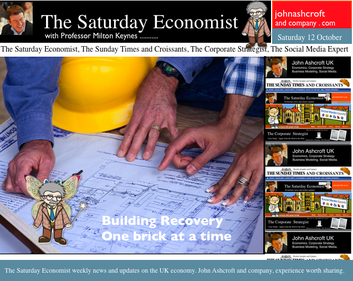 Economics news – Building recovery one brick at time .. Construction data Good news this week from the construction sector. Output in August was up by 4% compared to August last year. New work increased by almost 6% driven by developments in the housing market. FLS and Help to Buy are stimulating new mortgage activity on a really significant scale. The Council of Mortgage Lenders announced home-owner house purchase lending was up by 15% on August last year. First-time buyers took out 27,100 loans in August, an increase of 33% compared to August 2012. The house market is on the move. We expect the surge in housing activity to continue into the final quarter of the year and into 2014. Do we really need “Help to Buy Phase 2” probably not. No need to pay for a landslide, the economic recovery secured. We have increased our forecasts for GDP growth this year to 1.5% increasing to 2.5% next year. NIESR monthly GDP data Our estimates are in line with the NIESR monthly GDP tracker for September, released this week. The (NIESR) GDP rate of growth in the third quarter was 1.6% year on year. We expect the rate of growth to accelerate further into the final quarter towards trend rate of 2.4%, driven by a steady recovery in the service sector and a big push in construction output. Monetary Policy No surprise this week the MPC voted to keep interest rates and QE on hold. Forward Guidance is the new mantra. UK base rates will not rise until the U rate falls to 7%, assuming no shocks to the monetary system and the inflation outlook. In the USA, the Fed continued with the monthly asset purchases of $85 billion. What is it about the USA? The Fed might as well commit dollars to a NASDAQ tracker fund to sustain confidence in the markets. “Tapering will not begin until the DOW hits 17,000 could be the new forward guidance. Janet Yellen is to replace an exhausted Bernanke. Such a dove, they should “paint her white and give her wings”, the markets will love Planet Janet orbiting, as it will, around Planet ZIRP. So what of the UK recovery? The trade figures and manufacturing data were also released this week. Remember, "the march of the makers, rebuilding the workshop of the world, rebalancing the UK economy away from domestic consumption with an improvement in net trade"? Well forget that. The professor (Milton Keynes) invested in a sandwich board and spent his summer holidays in Cornwall this year. Stationed at Land’s End, facing Western traffic, the sign read “sail on - the earth is not flat”. “We get the message” shouted a wise cracking grockle. The professor turned to reveal the message on the other side, “Exports will not lead a UK recovery”, “yeah but how long did it take”, replied the perspicacious prof. Trade Data And so it proved with the trade data this month. The trade in goods deficit was £9.6 billion in August. We expect a deficit of £29 billion in the quarter compared to £26 billion last year. Our forecast for the year, is now at the top end for the year as a whole around £110 billion. The UK recovery will exacerbate the deficit. Monthly data can be erratic but fifty year trends provide a certain guide. The UK cannot grow faster than Europe and the USA without a significant deterioration in net trade in goods. Is this such a problem? Not really. The surplus on services will mitigate the deficit to around £30 billion. At 2% of GDP this is neither a threat to sterling nor a constraint to growth. Manufacturing The march of the makers skipped a drum beat in August as output fell by -0.2% compared to August last year. Consumer goods output fell by just over 2% as capital goods growth slowed to a similar level. We expect a better performance in September and in the final quarter of the year. Housing new build and a higher level of transactions will stimulate direct related construction output, (bricks & mortar). Housing related spending on products including furniture and carpets will also stimulate growth. So what does this all mean? The economy is recovering and growing at a much faster rate into the final quarter. Will US debt intransigence derail recovery? We assume not. If you lived through the Cuban missile crisis and the era of an international nuclear strategy underwritten by the concept of Mutually Assured Destruction, (They call it MAD), You assume sooner or later, the Republican ships will turn around and avoid the disaster that could unfold. Failing that, the President can always mint a few Trillion Dollar Platinum coins, develop section four of the fourteenth amendment or invoke the 1861 Feed and Forage Act. Union soldiers were allowed to “eat your crops, kill your chickens and water their horses”. The Act ensured, sooner or later, Congress would enact the necessary appropriation. The troops had to eat even though the deficit had not been approved. And so it is with debt markets, “let them eat noodles” is no message to send to international creditors. What happened to sterling? Sterling moved down against the dollar and against the Euro. The pound closed at £1.5954 from $1.6012. Against the Euro, Sterling closed at €1.1772 from €1.1816. The dollar moved up against the yen closing at ¥98.5 from ¥97.4.The dollar euro cross rate at 1.3542 was largely unchanged from 1.3556 Oil Price Brent Crude closed at $111.28 from $109.46. The average price in October last year was almost $112. We expect oil to average $112 in the month, with no real inflationary impact. Markets, rallied - The Dow closed at 15,237 from 15,073. The FTSE closed at 6,487 from 6,454. The markets sense a deal on the deficit is in sight. UK Ten year gilt yields closed at 2.74 from 2.75, US Treasury yields closed at 2.69 from 2.64. Gold closed at $1,270 from $1,310. The bulls have it or do they? Gold will trade sideways for some time yet. That’s all for this week, don’t miss The Sunday Times and Croissants out tomorrow. Join the mailing list for The Saturday Economist or please forward to a colleague or friend. UK Economics news and analysis : no politics, no dogma, no polemics, just facts. John © 2013 The Saturday Economist. By John Ashcroft and Company, Dimensions of Strategy. The material is based upon information which we consider to be reliable but we do not represent that it is accurate or complete and it should not be relied upon as such. We accept no liability for errors, or omissions of opinion or fact. In particular, no reliance should be placed on the comments on trends in financial markets. The receipt of this email should not be construed as the giving of investment advice. It's just for fun, what's not to like! Dr John Ashcroft is The Saturday Economist. 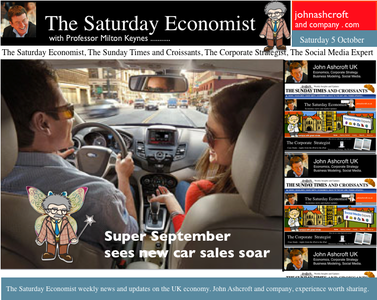 Economics news – Super September sees new car sales soar New Car Sales September new car registrations produced the highest monthly figure since March 2008 as sales totaled just over 400,000 units. Compared to last September sales were up by 12%. The UK car market is on track to sell 2.25 million units in the year up by 10% on 2012. Mike Hawes, Chief Executive of the SMMT said “Robust private demand has played a major role in this growth with customers attracted by exciting, increasingly fuel-efficient new models”. Private registrations have risen by 17% in the year, a measure of the strength of consumer demand. Markit/CIPS UK PMI® data The Markit/CIPS UK PMI® data series were released this week providing more good news on the strength of the economy. Manufacturing The UK manufacturing sector continued to expand at a marked pace in the month to round off its strongest quarterly performance since the opening quarter of 2011. At 56.7 in September, the seasonally adjusted Markit/CIPS Purchasing Manager’s Index® (PMI®) remained in expansion territory for the sixth successive month and was little-changed from August’s two-and-a-half year peak of 57.1. Service Sector The UK service sector continued to perform strongly in September to round off the best quarterly performance of the sector since Q2 1997. Activity and new business both rose at rates close to the August high. The Business Activity Index, recorded a level of 60.3, fractionally down on August’s near seven-year high of 60.5. Construction In the construction sector, the headline Markit/CIPS UK Construction Purchasing Managers’ Index® (PMI®) posted 58.9 in September, down only fractionally from a near six-year high of 59.1in August. The index was above the neutral 50.0 value for the fifth month running and signaled a sharp expansion of overall construction output. Housing construction activity increased at the fastest pace for almost a decade. So what does this all mean? The economy is recovering and growing at a much faster rate into the second half of the year. The service sector has maintained steady progress since 2009 growing at 1.6%. The manufacturing sector is recovering but the construction sector, particularly housing, is providing the significant boost to output. We think new housing, starts and completions, could grow by 30% this year boosting overall construction output by over 4% in the second half. This is the primary reason we have increased forecasts for 2013 to 1.5%. GDP growth is on track for 2.5% next year. Growth, inflation, jobs and even the borrowing figures are heading in the right direction. The trade figures alone will continue to disappoint. The UK cannot grow faster than major trade partners without exacerbating the external deficit. What happened to sterling? Sterling moved down against the dollar and against the Euro. The pound closed at £1.6012 from $1.6150. Against the Euro, Sterling closed at €1.1816 from €1.1935. The dollar moved down against the yen closing at ¥97.4 from ¥98.2.The dollar euro cross rate at 1.3556 was largely unchanged from 1.3530 Oil Price Brent Crude closed at $109.46 from $108.63. The average price in October last year was almost $112. We expect oil to average $112 in the current quarter, with no real inflationary impact. Markets, slipped - The Dow closed at 15,073 from 15,258. The FTSE closed at 6,454 from 6,512. The impasse on the US budget and government shut down appears to have damaged UK investment sentiment more than the US. UK Ten year gilt yields closed at 2.75 from 2.73, US Treasury yields closed at 2.64 from 2.63. Gold closed at $1,310 from $1,3361. The bulls have it or do they? Gold will trade sideways for some time yet. That’s all for this week, don’t miss The Sunday Times and Croissants out tomorrow. Join the mailing list for The Saturday Economist or forward to a friend UK Economics news and analysis : no politics, no dogma, no polemics, just facts. John © 2013 The Saturday Economist, #TheSaturdayEconomist, by John Ashcroft and Company, The material is based upon information which we consider to be reliable but we do not represent that it is accurate or complete and it should not be relied upon as such. We accept no liability for errors, or omissions of opinion or fact. In particular, no reliance should be placed on the comments on trends in financial markets. The receipt of this email should not be construed as the giving of investment advice. 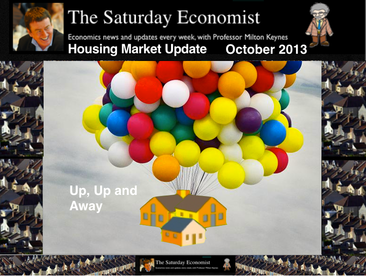 1 House Prices set to rise by over 5% this year and by over 8% in 2014. House prices are rising with the latest data from Nationwide and Halifax suggesting house prices are rising by 5%. Data from the ONS, indicates prices are rising slightly less in the information available to July. We expect the year on year out turn to be around 5.5% with a further increase in prices of between 7.5% to 10% next year. Download the full report below ... 2 Regional Prices will rise too ... London and the South East are leading the way with price rises averaging 10% in London based on both the Nationwide and ONS data. The ONS suggest prices are increasing less markedly across the regions with some indication prices are still falling in the North West. The Nationwide data suggests the increases are far more widespread averaging over 3.5% across the UK, with marked increases in the East Midlands specifically. Price rises will spread across the UK, like a tidal wave across the flood plain. We expect an acceleration of house prices across the regions into the final quarter of 2014 and into 2015. 3 Long Term Fundamentals support the price move The Nationwide long term fundamentals will support the price rise. Real long term house prices are below the trend rate. And the house price to earnings ratio appears to have established a resilient higher level post 2008. 4 As prices rise, the real cost of borrowing falls As prices rise, the real cost of borrowing falls and with no immediate base rate rises on the horizon for a further two years, the real cost of borrowing will fall to -2% or more increasing to -5% next year. Of itself this is a great stimulus to house market activity. 5 Mortgage Lending will increase by over 20% this year Mortgage lending is set to increase by over 30% in the third quarter and by over 20% for the year as a whole. This will still be less than half the activity at peak of market but a dramatic turnaround in any case. We anticipate an increase in lending to over £225 billion by 2015. 6 Housing transactions will increase by over 12% this year Housing transactions, after a slow start to the year, will increase by 24% in the third quarter and by over 12.5% for the year as a whole. We are projecting an increase to over one million transactions in the year, still well down on the peak 1.8 million in 2007 but a significant recovery from the lows of 2008-9. 7 House building set to increase by over 30% House builders are reacting to the recovery with a significant increase in housing starts. We are forecasting an increase of 30% over the year as activity accelerates into the second half. We expect further skill shortages in bricklaying and plastering and a significant increase in the cost per 000 index for brick layers. 8 Is this the right time for Help to Buy Stage 2? Probably not. The house market is on the move. No need to impart a significant demand shock to the recovery which the help to buy scheme represents. The scheme could increase house market transactions by as much as 100,000 in each of three years. The housing sector may increase the new build from 125,000 last year to over 150,000 this year. If we assume further supply increase in 2014, cost price pressures will begin to place additional pressure on the demand price shock. The Bank of England will not hesitate to take action in this cycle to mitigate price increases. Help to buy will be pared back in the September 2014 review. The spreads on high LTV loans will rise and higher capital provisions for high LTV lending will be in the mixer. John Ashcroft October 2013
|
The Saturday EconomistAuthorJohn Ashcroft publishes the Saturday Economist. Join the mailing list for updates on the UK and World Economy. Archives
July 2024
Categories
All
|
||||||
| The Saturday Economist |
The material is based upon information which we consider to be reliable but we do not represent that it is accurate or complete and it should not be relied upon as such. We accept no liability for errors, or omissions of opinion or fact. In particular, no reliance should be placed on the comments on trends in financial markets. The presentation should not be construed as the giving of investment advice.
|
The Saturday Economist, weekly updates on the UK economy.
Sign Up Now! Stay Up To Date! | Privacy Policy | Terms and Conditions | |
 RSS Feed
RSS Feed